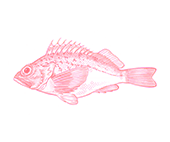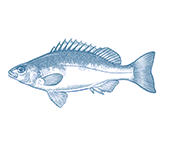




- Under Review
Wild Caught
Region:
WA
Note: Choose Saddletail snapper from the WA trap and line fishery if available. If you can’t be sure or it is only available from the Pilbara Trawl then choose a sustainable alternative below.
- This GoodFish assessment of saddletail snapper caught in WA is currently under review due to serious sustainability concerns reported by Government.
- Saddletail Snapper is a tropical reef fish species caught in QLD, the NT and WA.
- Saddletail snapper is caught in two multispecies fisheries in WA’s Kimberley and Pilbara, using line, trap and bottom trawl fishing methods.
- WA saddletail snapper populations are not directly assessed by scientists, instead it is inferred from the health of other species. Relatively high catches of saddletail snapper create some concern under this arrangement, though there is no evidence of serious overfishing.
- Line and trap fishing methods pose a low risk to vulnerable bycatch species and habitats. There is concern with the Pilbara Trawl fishery due to ongoing dolphin deaths and the failure of fishery managers to implement robust independent scrutiny of the fishery's bycatch
- The trawl fishery’s habitat impacts are relatively well understood, and their environmental risk is adequately managed.
- WA Northern Demersal Scalefish Fishery and Pilbara Demersal Scalefish Fishery (322t in 2021)
This GoodFish assessment of saddletail snapper caught in WA is currently under review due to serious sustainability concerns reported by Government.
Saddletail Snapper is a tropical species found across northern Australia but fished and managed by different jurisdictions. There are commercial fisheries in QLD, NT and WA.
Saddletail Snapper are caught as a secondary species in multi-species line, trap and bottom trawl fisheries in the Kimberley and Pilbara. About 35% of the catch comes from bottom trawl fishing.
The health of Saddletail snapper populations are not assessed directly, but on the basis of several other species that represent a proxy for the health of the suite of species in the fishery as a whole. This is concerning, as saddletail snapper catches have increased significantly in recent years to >300t/yr, a level that warrants direct scientific assessment. Given these significant catches and rudimentary management arrangements, there is considered some risk to saddletail snapper populations though there is no evidence of serious overfishing.
Line and trap fishing methods use are relatively targeted, and retain a broad range of species with little risk to endangered or vulnerable bycatch species and habitats.
The trawl fishery in which some saddletail snapper are caught has robust habitat management arrangements, and impacts of the fishery on habitats are well-studied.
Impacts of line and trap fishing on vulnerable habitats are less well understood, though the fishing method poses a low risk and extensive science-based marine parks across the Kimberley line and trap fishery afford considerable protection.
Some saddletail snapper are caught in a trawl fishery that operates in the Pilbara. This fishery has considerable issues with the bycatch of dolphins in fishing nets, and is not considered in this assessment. Saddletail snapper caught in the trawl fishery receive a Red, ‘Say No’ rating; however, the majority of saddletail snapper are caught using trap and line methods.
Independent fishery observer programs are an important method of verifying protected species interactions, as well as other fishery impacts, such as the type and volume of discarded catch. The line and trap fishery have no independent observation of fishing activity, but because line fishing methods are fairly targeted and have little threatened or protected species bycatch, there is low risk associated with this.
However, for the trawl fishery, since 2016 managers allowed trawl fishing boats to deactivate the onboard cameras that would have allowed independent scrutiny of fishing activity, as long as fishers voluntarily reported dolphin bycatch incidents that were within historic ranges. This creates three negative impacts – disincentivising fishers from reporting bycatch occurrences that exceed this range, removing the critical source of independent validation of bycatch reporting, and making public scrutiny of the fishery’s impacts more difficult. This is a serious failure of management and will require immediate effective action to improve the GoodFish ranking of this fishery in future. Trawl-caught saddletail snapper is ranked GoodFish Say No for this reason.
Line and trap-caught saddletail snapper are a much more sustainable seafood option and should be chosen over traw-caught wherever possible.


